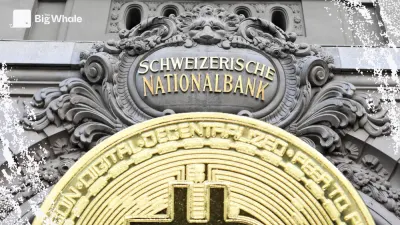TBW - Alexandre Baradez (IG): "I feel more confident about Bitcoin today than about the S&P 500"

We've seen signs of stress around private credit and US regional banks. Is this a real issue or just a passing warning?
Yes, it is a real stress signal. In recent weeks, several players have announced bankruptcies or losses (First Brands, Tricolor, Zions Bank). All this shows that banking risk is back on the radar. For the moment, it is mainly the US regional banks that are shaking, as in 2022 with Silicon Valley Bank. We're not there yet, but the same climate of uncertainty is evident. Even Jamie Dimon, the boss of JPMorgan, has acknowledged losses and warned that there could be further "surprises" after fourteen years of continuous expansion in private credit. The credit market, whether banking or non-banking, has grown without interruption since the 2008 crisis. It is normal for certain fragilities to reappear now that liquidity is contracting.
What is also at stake is Fed policy. We are starting to feel the effects of a balance sheet that has shrunk too much. The situation is a bit like 2018: after several years of tightening, liquidity began to run out and interbank rates climbed. We are now seeing the same phenomenon in a milder form: very short-term rates, such as SOFR, are rising, a sign that banks have a little less confidence in each other. This is not yet a crisis, but it is a warning. At the time, the Fed reacted quickly by injecting $400 billion into the system. Its chairman Jerome Powell seems to be preparing to do the same thing again. He has already opened the door to a pause in quantitative tightening, i.e. a halt to the reduction of the balance sheet. If banking tensions persist, the Fed could move quickly to put liquidity back into the system before the end of the year. This would be a way of easing the markets without needing to cut rates sharply.
>> Discover our stablecoin dashboard
Could the Fed really return to a more accommodative policy so quickly?
Normally, the Fed proceeds in stages: first it slows down the reduction in the balance sheet, then it stops it, and only then does it start injecting liquidity again. But if the situation becomes too tense too quickly, it can skip stages. In the event of interbank stress or mistrust between banks, it will not hesitate to intervene more forcefully. Everything will depend on the scale of the problem in the coming weeks. For the time being, the central scenario remains one of stabilisation, not crisis, but the signals should be watched closely. It is often at times like these that the Fed shows its pragmatism: it knows that liquidity is the lifeblood of the financial system, and that if it freezes, everything else grinds to a halt.
In Europe, the situation is very different. European banks are much more regulated and have very high capital ratios. This limits their risk-taking but reinforces their solidity. We're not at all in the scenario of a crisis like that of 2011 or 2012. The real issue is once again the US regional banks. They are much more exposed to SMEs and cost-sensitive sectors (such as manufacturing and trade), which are currently suffering from tariffs and the fall in the dollar. For these companies, margins are already fragile and financing costs remain very high. In the United States, the average credit card rate is over 21%, an all-time high. This pressure is having an impact on small businesses, and therefore on their partner banks. It is this intermediate link in the system that is the most vulnerable, much more so than large groups such as JPMorgan or Goldman Sachs.
China USA: "The APEC summit, scheduled for the end of October, will be decisive"
Trade tensions between the United States and China appear to have eased this week after Trump's pressure move on 10 October. Will it last?
Let's just say it's a fragile lull. The pattern has become almost habitual: Trump puts on the pressure with threats of taxes, then backs down to get a better deal. This is his way of negotiating. Until now, the markets have always interpreted these tensions as opportunities to buy on the pullback. But this time, the context is a little different. The agreement reached in June on rare earths and certain technology exports has not really been respected. As a result, the truce seems more fragile than it appears. The 3% fall in the markets last week is not dramatic, but it reflects this loss of confidence in the trade relationship between the two powers.
The APEC summit, scheduled for the end of October, will be decisive. If Trump and Xi Jinping meet, it may revive some hope of appeasement. If he cancels, there is a risk that the markets will fall further, as the meeting acts as a kind of "psychological safety net". Conversely, a successful meeting, even without a concrete agreement, would be enough to calm things down. We can also see that US officials are keeping a close eye on the markets: US Trade Representative Jamieson Greer has made it clear that they are monitoring developments in equities and bonds. This means that they know how far the pressure can go before it becomes dangerous. As long as the fall remains limited, they'll leave it alone, but if there's a real slippage, they can very quickly change their tune. So the most likely scenario remains one of a controlled tug of war.
Markets are still anticipating two more rate cuts between now and the end of the year. Is this reassuring or worrying?
It all depends on why the Fed is cutting rates. If it's doing so because the economy remains solid and it wants to support growth, that's positive. But if it does so because it senses that something is breaking, that's another signal. We have already seen this situation during the subprime crisis: rate cuts were in fact emergency reactions to underlying stress. Today, we are somewhere between the two. The Fed has already begun to ease policy, initially to support employment, and is expected to continue to do so in October and December. Two cuts of 25 basis points is the central scenario. But if banking tensions worsen, it could go as high as 50 basis points all at once. It has already proved in the past that it can act quickly, in either direction.
The idea is not to trigger another massive quantitative easing, but to put some oxygen back into the system. Rates are falling with a delay, whereas a halt to balance sheet tightening acts straight away. This is undoubtedly the first step. Then, if the situation remains tense, the Fed could go further. These decisions should not be seen as a signal of panic, but rather as a means of preventing a small liquidity problem from turning into a larger crisis. For the markets, this kind of announcement often creates a double effect: a little concern in the short term, because it confirms that there is tension, but real support in the medium term, because it helps to avoid contagion. This is the logic behind Jerome Powell's action today.
>> Datas, insights, etc. Discover our Bitcoin dashboard
Bitcoin: "These levels may even represent interesting entry points for patient investors"
Bitcoin has fallen a lot in recent days. Is the bull-run over?
No, I don't think the bull cycle is over. What we've seen recently is mostly a purge of leverage. When volatility increases on traditional markets, investors first reduce their riskiest positions - and cryptos are always at the top of this risk pyramid. It's a mechanical process. Bitcoin had been trading fairly steadily for several months at between $110,000 and $125,000. Friday's fall was brutal, but above all it cleaned up the market. We are gradually returning to more reasonable levels, between 90,000 and 100,000 dollars, without this calling into question the underlying trend. In the short term, I think these levels may even represent attractive entry points for patient investors.
We must not forget that the crypto market is now much more institutionalised than it used to be. ETFs, asset managers and companies are now stakeholders. This makes the market more stable over time. We are no longer looking at extreme cycles like in 2018 or 2021. What is possible is a phase of boredom: a large sideways range where the market consolidates for several months. ETF flows will be a good indicator to follow: if they remain positive despite the fall, it will mean that institutional investors are continuing to accumulate. In my view, this is more of a breathing space than the end of a cycle. And with interest rates set to fall and liquidity returning, Bitcoin still has a long way to go.
Gold has been breaking all records for several weeks. Are we in a bubble?
Gold has clearly benefited from a perfect alignment of favourable factors. Initially, the rise was justified: since the war in Ukraine, many central banks have increased their gold reserves to protect themselves from US sanctions and dependence on the dollar. China, India, Russia and other emerging countries have bought up the metal on a massive scale to diversify their reserves. At the same time, the fall in the dollar and the prospect of lower interest rates have made gold even more attractive. By 2025, people will be buying gold not only as a safe haven, but also as a hedge against a loss of confidence in the monetary system. And the more the geopolitical climate becomes tense (between Trump, China or Russia), the more gold appears as insurance.
But in recent weeks, we have entered a much more speculative phase. The price of gold is now moving in an almost irrational mode, fuelled by short-term buying. When investors rush into the metal to follow the trend rather than to protect themselves, it is often a sign of excess. We could yet see a final peak, but the risk of a correction is becoming significant. A fall of 10-20% would not be a catastrophe; it would even be a healthy breather after such a vertical rally. At these levels, buying gold is more about fashion than caution. If geopolitical tensions ease a little (particularly around Ukraine and the Middle East), the price of gold could logically fall back. This would not be a fundamental reversal, but rather a normalisation.
US consumption: "This is the factor that can turn a simple correction into a real slowdown."
What should we be watching in the coming weeks to hope for a return of risk-on in the markets?
Three elements will be decisive: the situation of the banks, relations between Washington and Beijing, and Fed policy. If the banking problems calm down and the Fed stops tightening its balance sheet, that will be the first positive signal. If Trump and Xi Jinping find common ground, however limited, that would be a second signal. And if the Fed confirms two rate cuts between now and the end of the year, the combination of the three could give the markets some breathing space. But behind all this, there is one key player: the American consumer. They hold the economy together. And they are under pressure. Consumer credit rates are over 20%, rents are high and purchasing power is stagnating. It is this factor that can turn a simple correction into a real slowdown.
We also need to keep an eye on the risk of a "shutdown" in the United States, i.e. the temporary closure of federal administrations if Congress fails to agree on the budget. This could cost the economy up to 15 billion dollars a week, even if some of it is later made up. The most dangerous thing is not the direct cost, but the loss of confidence it causes. If consumer spending slows, the Fed will be forced to act more quickly to avoid a recession. Furthermore, the results of the major technology companies will be closely scrutinised. These are the companies that have driven US growth in recent quarters thanks to their massive investments. If their prospects darken, this will weigh not only on the markets, but also on GDP. To sum up: if consumption holds up and the Fed remains flexible, the risk of a major crisis will remain limited.
In this context, is this rather a moment of opportunity or a moment of caution?
It is a moment of transition, not yet of opportunity. US equity markets remain very expensive, with valuations close to those of the post-Covid bubble. Retail investors are extremely exposed, sometimes more so than at the end of the 1990s. This kind of configuration often ends in a correction. The market needs to be 'cleaned up': a real fall of 10-15% accompanied by a spike in volatility to take the pressure off. Until we have had this moment of purging, it is too early to go back to buying US equities. It's not a question of pessimism, just common sense: we've had too much complacency, we need to rebalance.
On the other hand, I find that cryptos already offer interesting entry points. The correction was violent, but it allowed us to purge the leverage and return to healthier levels. Institutional flows remain solid, and if the Fed eases the pressure a little, liquidity will return. It's paradoxical, but today I feel more secure about Bitcoin than about the S&P 500. As for gold, it's too high to be an opportunity, unless we wait for a correction. We're in a phase where everything is rebalancing: the equity markets need a breather, cryptos are digesting, and monetary policy is about to tip. For a patient investor, this is a time to observe and prepare, not yet to go for it.
>> Markets: the dark weekend that shook cryptos



